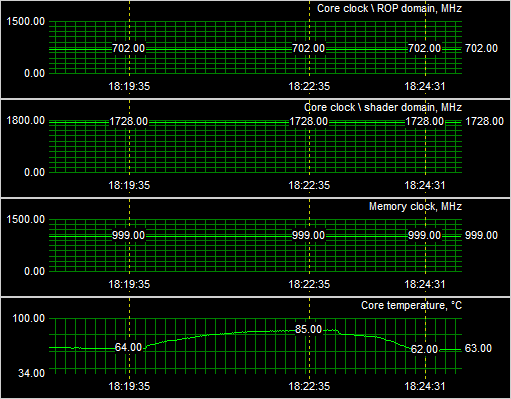Page 5 - Thermals and Noise levels
GeForce 8800 GT core temperature
Let's have a look at the temperatures these newly designed coolers produce. As always we measured at a room temperature of 21-22 Degrees C. First let's peek at the thermal envelope on the chart.
|
|
||
 |
||
It's quite interesting. First off, I'm only showing one measured temperature envelope as despite the slightly high clock on the POV card, the temperatures were 99% identical. Now despite the big two-slot cooler, we again see pretty high temperatures. The 8800 GT already was showing off really abnormal temps, and so does the 8800 GTS 512MB. If you stress the graphics card hard enough your temperature will reach 85 degrees C easily, whereas in idle we will also see 60-65 degrees C. We still had plenty of headroom to overclock and not once, seriously not once, during our tests did we have a crash.
Hot or not, the GPU can manage the thermals very well as it seems. You can always grab Rivatuner and set the fan RPM a little higher. It'll have an immediate and direct effect on temperatures.
The disadvantage for a GeForce 8800 GT is that the residual heat is dumped inside your PC. The good thing about a dual-slot cooler is that hot air is exhausted outside the PC. Since I do not want my other computer components to heat up due to a graphics card ... the dual-slot cooler has my preference.
Noise Levels coming from the graphics card
When graphics cards produce a lot of heat, usually that heat needs to be transported away from the hot core as fast as possible. Often you'll see massive active fan solutions that can indeed get rid of the heat, yet all the fans these days make the PC a noisy son of a gun. I'm doing a little try out today with noise monitoring, so basically the test we do is extremely subjective. We bought a certified dBA meter and will start measuring how many dBA originate from the PC. Why is this subjective you ask? Well, there is always noise in the background, from the streets, from the HD, PSU fan etc etc, so this is by a mile or two not a precise measurement. You could only achieve objective measurement in a sound test chamber.
The human hearing system has different sensitivities at different frequencies. This means that the perception of noise is not at all equal at every frequency. Noise with significant measured levels (in dB) at high or low frequencies will not be as annoying as it would be when its energy is concentrated in the middle frequencies. In other words, the measured noise levels in dB will not reflect the actual human perception of the loudness of the noise. That's why we measure the dBa level. A specific circuit is added to the sound level meter to correct its reading in regard to this concept. This reading is the noise level in dBA. The letter A is added to indicate the correction that was made in the measurement. Frequencies below 1kHz and above 6kHz are attenuated, where as frequencies between 1kHz and 6kHz are amplified by the A weighting.
|
|
|||||||||||||||||||||||||||||||||||||||
|
|||||||||||||||||||||||||||||||||||||||
We startup a benchmark and leave it running for a while. The fan starts to rotate faster and makes a moderate noise. We take the dBA meter, move away 75 cm and then aim the device at the active fan on the graphics card. We measure roughly 40 dBA which is to be considered a quiet to moderate quiet noise level coming from the PC, yet also a norm as most of our tests end up at this sound level. Again, this is a very subjective test and that dBa level includes all noise in the environment.
By the way, we always measure during a 3D intensive test, so we know that the cooler has a higher rotational RPM opposed to doing nothing in desktop mode. Once the GPU is really heating up, you will sometimes hear the fan way more clearly. It doesn't make a large difference in DBA, yet you can hear a high pitch noise coming from the fan.
